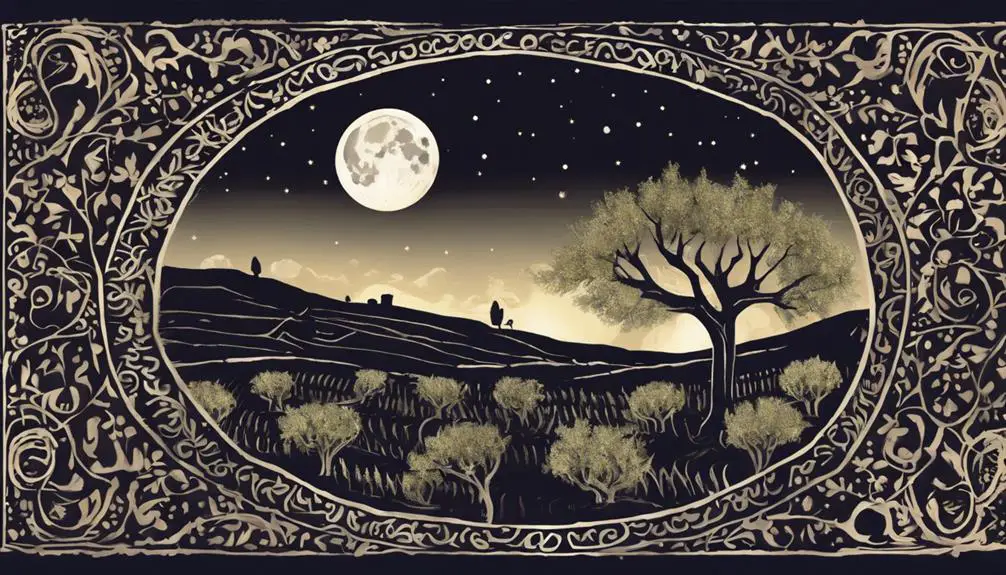Uncover the spiritual depths of Tishri in the Bible, a month rich with ancient festivals and modern reflections that beckon further exploration.

Tishri in the Bible
Imagine the crisp air of early autumn in ancient Israel, where the month of Tishri ushers in a period of reflection, celebration, and renewal. You're about to embark on a journey that explores Tishri's profound significance in the Bible, from its historical context to the vibrant festivals that mark this time.
This month holds a treasure trove of spiritual insights and rituals, deeply rooted in the Biblical narrative and extending into contemporary observances. By understanding Tishri's place in biblical texts and its impact on modern practices, you'll uncover layers of meaning that continue to resonate today.
Let's explore why this period is so pivotal.
Key Takeaways
- Tishri is central to Jewish observances, as detailed in Leviticus 23, Numbers 29, and Deuteronomy 16.
- Its etymology signifies initiation and a period of transition, reflecting its spiritual significance.
- The month bridges sacred and mundane, emphasizing the role of divine providence in daily life.
- Observances during Tishri commemorate both the agricultural cycle and divine blessings.
Historical Context of Tishri

To grasp the significance of Tishri in ancient times, it's essential to understand its foundational role in the Hebrew calendar as the seventh month, marking a period replete with religious observances and agricultural activities. This month's timing, governed by lunar synchronization, intricately tied the community's spiritual life with the rhythm of nature. Unlike the solar calendar, which can drift from the agricultural cycle, the lunar-based system ensured that Tishri always aligned with specific seasonal transitions crucial for farming practices.
You'll find that agricultural practices during Tishri were meticulously planned to coincide with this period. The month's start signaled the end of the harvest season, a critical time for ancient communities dependent on their crops for survival. This alignment wasn't coincidental but a sophisticated integration of astronomical observations with agricultural necessities, ensuring food security and societal stability.
Moreover, the lunar synchronization offered a reliable timeframe for agricultural activities. Planting, harvesting, and other critical farming operations were scheduled around the lunar calendar's cues, embedding Tishri's significance not just in religious observances but also in the very sustenance of the community. This dual role underscores the month's pivotal place in ancient Hebrew society, bridging the sacred and the mundane through a harmonious balance between celestial cycles and earthly needs.
Spiritual Significance

The spiritual significance of Tishri in the Hebrew calendar extends beyond its agricultural importance, serving as a cornerstone for numerous religious observances and reflections. Tishri reflections pivot around themes of spiritual renewal, introspection, and the impermanence of life, urging you to reassess your actions, thoughts, and commitments. This period beckons you to a deeper understanding of your spiritual journey, emphasizing the transient nature of existence and the perpetual opportunity for renewal.
Aspect |
Description |
Impact on Individual |
|---|---|---|
Reflection |
Introspection on past deeds and decisions. |
Fosters personal growth and accountability. |
Renewal |
Embracing change and new beginnings. |
Encourages spiritual rejuvenation and hope. |
Impermanence |
Acknowledging life's transient nature. |
Cultivates humility and appreciation for the moment. |
Commitment |
Reassessing and reaffirming spiritual and personal commitments. |
Strengthens resolve and purpose. |
Action |
Translating reflections into tangible changes. |
Promotes ethical living and community betterment. |
Diving into Tishri's spiritual essence, you're invited to explore these dimensions, transforming your reflections into actions that align with your deepest values. This period becomes a scaffold for spiritual renewal, guiding you towards a more meaningful, purpose-driven existence.
Major Festivals Explained

Exploring the spiritual essence of Tishri further, let's examine the major festivals that define this period, each embodying unique religious and historical significances.
- Rosh Hashanah: Often known as the Jewish New Year, this festival marks the start of Tishri. Its origins can be traced back to biblical times, serving as a day of judgment and remembrance. Agriculturally, it signifies the beginning of the fall harvest, linking the spiritual renewal with the land's bounty.
- Yom Kippur: This Day of Atonement is the holiest day in the Jewish calendar. It's a time for reflection, repentance, and seeking forgiveness. Historically, it involves a series of rituals designed to purify and renew the community and the individual.
- Sukkot: Celebrated for seven days following Yom Kippur, Sukkot commemorates the Israelites' 40-year journey in the desert after their exodus from Egypt. Its agricultural connections are evident in its celebration of the harvest season, with the construction of temporary shelters (sukkahs) that hark back to the fragile dwellings of the Israelites.
- Shemini Atzeret and Simchat Torah: These festivals mark the end of Sukkot and celebrate the conclusion and immediate renewal of the annual Torah reading cycle, blending historical reverence with joyous agricultural appreciation.
Tishri in Biblical Texts

Delving into biblical texts, we find Tishri at the heart of some of Judaism's most profound observances, each steeped in layers of spiritual and historical significance. The etymology of Tishri itself, originating from ancient Semitic roots, hints at the beginning or initiation, aligning with its position as the head of the Jewish civil year. This month, marking a period of transition, intertwines deeply with agricultural connections, reflecting the harvest time in the Land of Israel.
The biblical injunctions for the observances in Tishri, such as the Feast of Trumpets (Rosh Hashanah), the Day of Atonement (Yom Kippur), and the Feast of Booths (Sukkot), are meticulously detailed, emphasizing their importance. These festivals, described in Leviticus 23, Numbers 29, and Deuteronomy 16, not only serve religious purposes but also commemorate the agricultural cycle—sowing, reaping, and giving thanks.
Analyses of these texts reveal a complex interplay between the sacred and the mundane, where Tishri serves as a bridge. Its agricultural connections remind followers of their dependence on divine providence for sustenance, while its etymology and observances invite reflection, renewal, and celebration.
Contemporary Observances

Building on the ancient foundations detailed in scriptural texts, today's observances of Tishri continue to embody a rich tapestry of spiritual renewal and communal celebration, deeply rooted in both historical and agricultural significance. These observances have evolved, incorporating modern adaptations that reflect changing societal norms and technological advancements, while still honoring their profound cultural impacts.
To make this analysis more engaging, consider the following aspects:
- Modern Adaptations: Advancements in technology have facilitated global connections, enabling diaspora communities to partake in Tishri celebrations in real-time with those in the homeland. This has significantly broadened the scope and inclusivity of observances.
- Cultural Impacts: The observances of Tishri serve as a critical vehicle for the transmission of cultural and religious identity, especially among younger generations. Through these celebrations, individuals reengage with their heritage, reinforcing communal bonds.
- Educational Initiatives: Innovative educational programs have emerged, aiming to deepen the understanding of Tishri's significance. These initiatives leverage multimedia resources to cater to diverse learning preferences, ensuring the traditions remain relevant and accessible.
- Interfaith Engagement: Tishri observances have become platforms for interfaith dialogue, promoting mutual respect and understanding across diverse religious communities. This has enriched the observances with new perspectives and fostered a sense of global unity.
Through these lenses, it's clear that contemporary observances of Tishri are vibrant, dynamic expressions of cultural resilience and spiritual reflection.
Frequently Asked Questions
How Do Different Jewish Communities Around the World Uniquely Celebrate or Observe Tishri, Beyond the Commonly Known Practices?
You're exploring how Jewish communities globally mark Tishri uniquely, beyond well-known traditions. These observations often center on community gatherings and spiritual reflections.
For example, some communities might host special outdoor events, blending nature with spiritual introspection.
Others could incorporate unique local customs into their observances, enriching the traditional celebrations with a distinct cultural flavor.
These practices offer a deeper, more personal way to experience the month, emphasizing communal and spiritual connections.
Are There Specific Foods or Recipes That Are Traditionally Associated With Tishri, and What Is Their Cultural Significance?
You're asking about traditional foods linked to a specific period, highlighting their cultural importance.
This time is marked by harvest symbolism, with foods reflecting seasonal abundance and gratitude. Seasonal decorations often accompany these meals, further embedding their significance.
Analyzing these culinary traditions reveals a deep connection to nature's cycles, underscoring their role in cultural identity and community cohesion. Each dish tells a story, woven from the threads of history, tradition, and environmental bounty.
How Has the Observance of Tishri and Its Associated Festivals Evolved Over the Centuries, Particularly in Response to Historical Events or Changes in Jewish Diaspora Communities?
You've seen observance practices and their festivals evolve significantly, influenced by historical events and shifts within Jewish diaspora communities.
Ancient rituals have been adapted to fit modern contexts, reflecting both preservation and innovation. These adaptations aren't just about survival; they're a testament to resilience and the ability to find relevance in changing times.
Modern adaptations ensure these practices remain vibrant and meaningful, even as they honor their ancient origins.
Can You Provide Examples of How Tishri and Its Festivals Have Been Depicted in Jewish Art, Literature, or Music Throughout History?
You'll find that Tishri's festivals have significantly influenced Jewish culture, manifesting in various forms of art. Tishri paintings often capture the solemnity and joy of these periods, blending traditional symbols with modern artistic expressions.
Similarly, Sukkot songs merge ancient melodies with contemporary lyrics, reflecting the community's enduring connection to these observances.
This blend of past and present in art, literature, and music underscores the festivals' evolving significance across time.
What Are Some Common Misconceptions or Lesser-Known Facts About Tishri That People Outside the Jewish Faith Might Not Be Aware Of?
You mightn't know that the etymology of Tishri traces back to ancient languages, hinting at its deep roots and significance.
Beyond spiritual observances, Tishri's agricultural significance is profound, marking a pivotal time in the farming calendar.
This period's importance goes beyond religious rites, intertwining with the land's seasonal rhythms and harvests.
This connection to agriculture is a lesser-known aspect that enriches our understanding of Tishri's multifaceted nature.
Conclusion
In conclusion, Tishri holds profound historical and spiritual significance within the biblical context, serving as a cornerstone for major Jewish festivals. Your exploration of Tishri in biblical texts reveals a rich tapestry of religious observance, highlighting its role in shaping contemporary practices.
Through an analytical lens, we've seen how these festivals aren't merely commemorations but deeply reflective periods that resonate with themes of renewal and repentance, underpinning the enduring relevance of Tishri in Jewish faith and culture.



Sign up